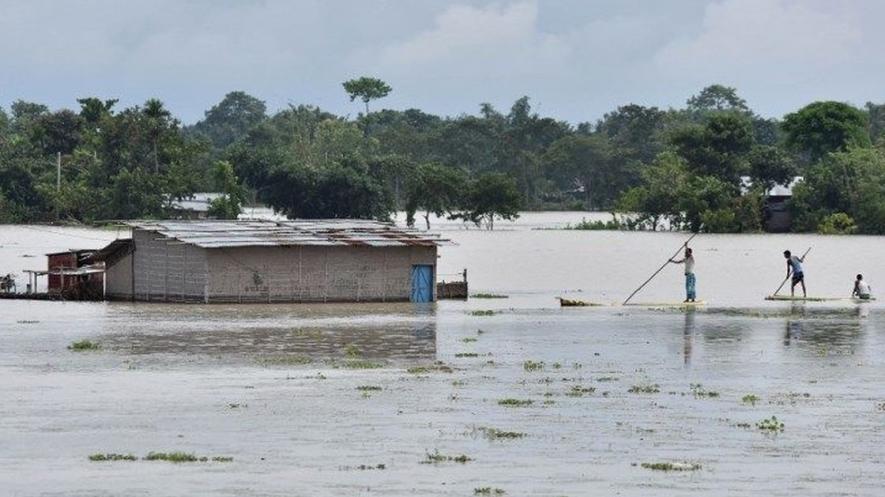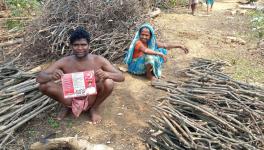Why Stronger Efforts are Needed During this Flood Season

Representational image. | Image Courtesy: Scroll.in
India’s flood control measures should be made exceptionally strong this year, especially in the known flood prone parts of the country. This is not a “normal” monsoon year due to several factors. Already, several millions have been affected by the ongoing floods in the eastern parts of the country. In these early days of the flood season, many parts of the country are already severely affected. This is because India has had the wettest June in 12 years, and the precipitation was concentrated in some regions. As a result, the capacity of the land to absorb water is quite exhausted.
Besides, due to the lockdown, the routine flood-protection work which normally starts in the summer, has been delayed in many places, Bihar in particular, but also Assam and eastern Uttar Pradesh. As Bihar is among the most flood-affected parts of the country these delays need to be made up before it is too late. In other states, particularly West Bengal, some river embankments were breached before the monsoon arrived in July due to cyclone Amphan. These require urgent attention: Last year, by 10 August, at least 700 people had died in the floods.
Finally, because of the Covid-19 pandemic, relief and rescue efforts will have to be far better organised by the Centre and state governments this year. In flood-prone zones where waterlogging is a recurrent phenomenon, people end up seeking shelter on elevated roads and embankments. In addition, the relief camps become extremely crowded and this raises an additional challenge: social-distancing norms need to be followed this year, along with the regular precautions that are generally taken against communicable diseases.
This year due to heavy rainfall flood-prone zones can expect more waterlogging than in normal monsoon years, and that will mean more diseases to tackle in the wake of floods. As most state governments have diverted their already inadequate health personnel and resources to tackle Covid-19, the capacity of the healthcare system is far lower. States must therefore begin preparing for the post-flood scenario early, as the rainy season has just gotten underway. This is particularly true in eastern Uttar Pradesh, where the monsoon is always harbinger of serious health problems.
Lightning strikes in eastern India, particularly Bihar and Uttar Pradesh, have added to the risks posed by the rainy season. On just one day around 120 people, most of them farmers, were killed in lightning strikes in Bihar. This scale of mortality is a rare phenomenon, but scientists must examine whether climate change has played a hand here. This is important for the nomads, pastoralists, forest produce gatherers, farm workers and destitute persons who have no access to shelters against thunderstorms. Lightning detecting sensor machines, which can even be linked with apps, can provide advance warning (of over half an hour) and save lives. Region-specific precautions and advance warnings also need to be publicised. Plus, there is need to provide treatment to victims, as injuries caused by lightning are painful and disabling.
Other factors that affect flood management include how well states manage their dams and water bodies. For instance, the state government of Maharashtra had sought a massive assistance from the Centre and even the corporate sector to deal with the extreme flooding event which was ultimately blamed on improper water management. In the past, the same scenario has unfolded in Gujarat, Karnataka and elsewhere.
During the monsoon, there is acute fodder shortage in rural areas, and the farmers who are poor also run out of essential supplies of hay. The prices of vegetables shoot up after floods, while some crops end up destroyed and others poise to require better market access in the post-flood environment. Floods also affect the small rural industries immensely, and this year the people who live in flood-prone regions face exceptionally high poverty and deprivation compared to previous years because of the ongoing pandemic. Particularly in Bihar, West Bengal and eastern Uttar Pradesh, there are no signs that economic activity will return to pre-Covid-19 levels despite a shortage of workers. Therefore, the need to allocate resources to meet people’s needs is even more urgent.
Frequent floods have made the population of many of the poorer states highly dependent on livelihoods in the cities. This year the migrant workers were forced to return to their homes in highly-distressing conditions with no cash, growing debt burdens and health problems. The migrants used to supplement their meagre resources, but this time they will need more government relief. Voluntary organisations and state government, along with the Centre, must prepare to extend assistance over a longer period in 2020.
Some assistance in the form of flood relief and rehabilitation is always provided at the time of floods and during their immediate aftermath. Yet, this assistance is generally inadequate, especially for the poorer households who suffer serious damage to their homes. There has also been an increase in the frequency of extreme weather events due to erratic weather conditions and probable effects of climate change.
Now, as winter approaches, the flood-affected people will need more than polythene sheets to shelter themselves. These families, particularly children, are highly vulnerable to disease, but by the time winter arrives, few still remember the flood-affected people or their needs. It is imperative that India provides these citizens immediate relief, including cash, to get by and rebuild their homes. It is unlikely that migrant workers will be back at work in towns and cities by winter.
Only those who have faced a flood can understand the pain and suffering it brings. Whatever else the flood season brings this year, it will require more resources to tackle the healthcare, relief and rehabilitation efforts than ever before. One hopes that our governments are planning accordingly.
The writer is a freelance journalist who has been involved with several social movements. The views are personal.
Get the latest reports & analysis with people's perspective on Protests, movements & deep analytical videos, discussions of the current affairs in your Telegram app. Subscribe to NewsClick's Telegram channel & get Real-Time updates on stories, as they get published on our website.
























